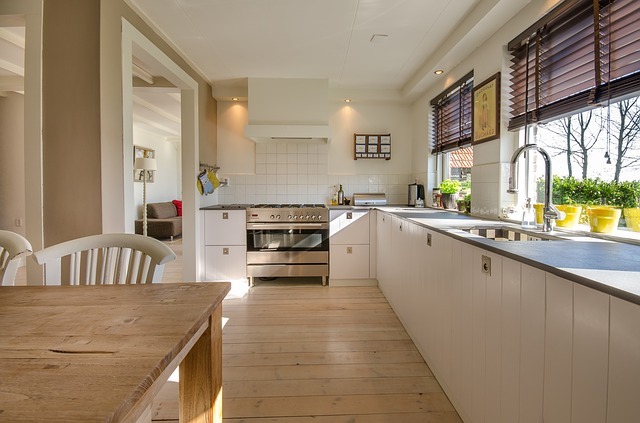Do you clean your kitchen floor every day? The dirt on the kitchen floor cannot be caught up with daily cleaning alone, and dirt often spreads to areas other than the floor. If you leave those stains unattended, they will become extra difficult to remove. In this article, we’ll show you how to clean your kitchen floor.
How to clean the kitchen floor?
Even if you plan to clean the kitchen floor every day, there are many things that are sticky and dark. Kitchen floors are particularly susceptible to stubborn stains. What is the best way to clean the kitchen floor? In this article, we will introduce how to clean and polish the kitchen floor to remove oil stains, stickiness, and blackheads.
Main causes of dirt on kitchen floors
The kitchen is where you handle food and should be kept as clean as possible. However, when you notice it, the floor is often covered with dirt and darkened. Dirt on the kitchen floor is difficult to remove, and if left unattended, it can cause discoloration of the floor. What exactly is causing those nasty stains on the kitchen floor?
① Oil splash
One of the causes of dirty kitchen floors is oil splatter. As you can see below, even if you have a mat in your kitchen, you can see that the cooking oil is off the mat and flies farther than you might imagine.
As a result of verification by an employee of a certain mat manufacturer, the number of oil splashes on the floor in one cooking was found as follows.
- 14 oil splashes from deep-fried food (area of 34cm x 82cm)
- 39 oil splashes from fried food (area of 71cm x 87cm)
Also, the oil that flew the farthest was on the floor about 140 cm away, far beyond the mat.
As well as cleaning the kitchen floor, let’s clean the kitchen mat frequently!
②Food scraps
Food scraps are the next most common cause of kitchen floor stains. During cooking in the kitchen, which we use every day, food scraps such as thrown vegetables, scraps from microwave ovens, toasters, etc., are unknowingly soiling the floor. Kitchen mats are also prone to food residue.
③ water splash
In kitchens and other places with water, water splashes all the way to the floor without you noticing it. Splashing water on the kitchen floor can cause deformation of the flooring, so wipe it down frequently every day.
④Dust
Kitchen floors can get dirty more easily than you think, especially if the kitchen floor is made of wooden floors, which can easily accumulate dust. Also, even if you clean frequently every day, hair and fine dust tend to accumulate, and the moisture makes it easier for dirt to stick to the floor.
⑤ Dark spots
Dark spots on kitchen floors are caused by a mixture of dust, oil stains, and mold. Therefore, if you do not leave the blackheads unattended, it will become a breeding ground for bacteria and mold. If you clean it frequently every day, you can somehow stop it before it turns black. Get rid of blackheads as soon as possible.
Make sure to check the washing instructions for the kitchen mat and wash it at least once a month. Also, when washing the mat, do not use fabric softener and shorten the dehydration time.
Read Also: Introducing 9 easy ways to dehumidify! How can I dehumidify quickly and efficiently?
How to clean kitchen floors by floor type
There are wooden floors, cushion floors, and floor tiles on the kitchen floor. Below are instructions on how to clean each type of flooring.
① How to clean the flooring
he usual way to remove stains from hardwood floors is to wipe them dry with a dry cloth or mop. However, stubborn stains on flooring can be wiped off with a cleaning solution diluted with detergent using a rag or mop after vacuuming. After wiping with water, wipe it twice. Once dry, apply a thin layer of wax along the grain of the flooring and allow it to dry.
flooring waxing
Ideally, flooring wax should be reapplied every six months, and the old wax should be removed every 3 to 5 years. Applying the wax twice will enhance the effect.
② How to clean the cushion floor
The cushion floor is made of vinyl chloride material, which is relatively easy to maintain. To remove dirt, use a damp cloth or mop after vacuuming. However, since it may come off with water, wring out the cloth or mop firmly before wiping. Applying a special resin wax will keep it clean for a long time.
Do not use alcohol or thinner to clean the cushion floor as it may discolor. Let’s dry thoroughly after wiping!
③ How to clean floor tiles
Floor tiles are PVC tiles and are often used in stores. To remove dirt from floor tiles, use a damp cloth or mop after vacuuming. In addition, if it is very dirty, please wipe it with a dishwashing detergent diluted with water. Regular waxing will prevent stains from sticking.
Before waxing the floor tiles, make sure that the wax is for PVC flooring.
